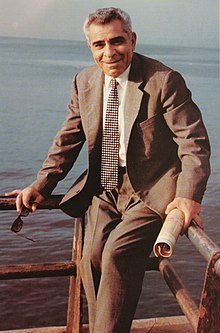Antranig Dzarugian
Antranig Dzarugian | |
|---|---|
 | |
| Born | 1913 Gürün,Sivas Vilayet,Ottoman Empire |
| Died | 1989 Paris, France |
| Occupation | Author, Poet |
| Nationality | Armenian |
| Genre | poetry, memoir |
| Subject | Society, politics |
Antranig Dzarugian(Անդրանիկ Ծառուկեան; 1913–1989 inParis) was an influentialdiasporanArmenianwriter, poet, educator, and journalist in the 20th century.[1]
Antranig Dzarugian (transliterated inEastern ArmenianasAndranik Tsarukian) was born inGürün,Sivas Vilayet,Ottoman Empirein 1913. He was related to Chello Toros (1871–1893), one of the fighters of theArmenian irregular unitsagainst the Ottoman Empire. During the years of theArmenian genocide,Dzarugian separated from his mother as a result of thedeath marchesin the Syrian desert and spent his childhood in the Armenian Orphanage ofAleppo.In 1921, he met his own mother in Aleppo and moved to the localHaygazian Armenian Schoolto receive his elementary education. In the same year, his father was arrested and killed in theMarashprison for his participation in the patriotic movement against the Ottoman Empire.[2]
After completing his elementary schooling in Aleppo, Dzarugian moved toBeirutto complete his education at the newly opened Armenian College. Among his teachers in the college were prominent Armenian educators such asNikol AghbalianandLevon Shant.He became a dropout, and later started his career as a teacher in the Armenian schools of Aleppo and Beirut. He says that his writings are influenced bySiamantoandDaniel Varoujan.[3]
Books and publications
[edit]He first published theNayiriliterary monthly in Aleppo (1945-1952), and afterwards he moved it to Beirut, where he published it as a literary, cultural and political weekly (1952-1983).
His first bookYegherapakhd Kertoghner(inArmenianԵղերաբախտ քերթողներ) was about Armenian poets and literary figures killed during theArmenian genocide.This was followed by the novelAshtray(inArmenianՄոխրաման). Among his most prominent works, "People Without Childhood" (inArmenianՄանկութիւն չունեցող մարդիկ, 1955) and "Ethereal Aleppo" (inArmenianԵրազային Հալէպը, 1980) are autobiographical accounts dedicated to his childhood life in the orphanage of Aleppo. Also very famous is hisLetter to Yerevan(inArmenianԹուղթ առ Երեւան). Dzarugian visitedSoviet Armeniafor the first time in 1956. His impressions of his frequent trips to the homeland were reflected in his books "Old Dreams, New Paths" (Հին երազներ, նոր ճամբաներ, 1958) and "New Armenia, New Armenians" (Նոր Հայաստան, նոր հայեր, 1983).
References
[edit]- ^acam-france.org
- ^Nshanag.net (in Armenian)
- ^Mikaelyan, Lilit (2021)."Կենդանագլուխ բարձրաքանդակները Բագրատունյաց Հայաստանի մի շարք եկեղեցիների հարդարանքում".Գիտական աշխատություններ:266–276.doi:10.52971/18294316-2021.3-266.ISSN1829-4316.
